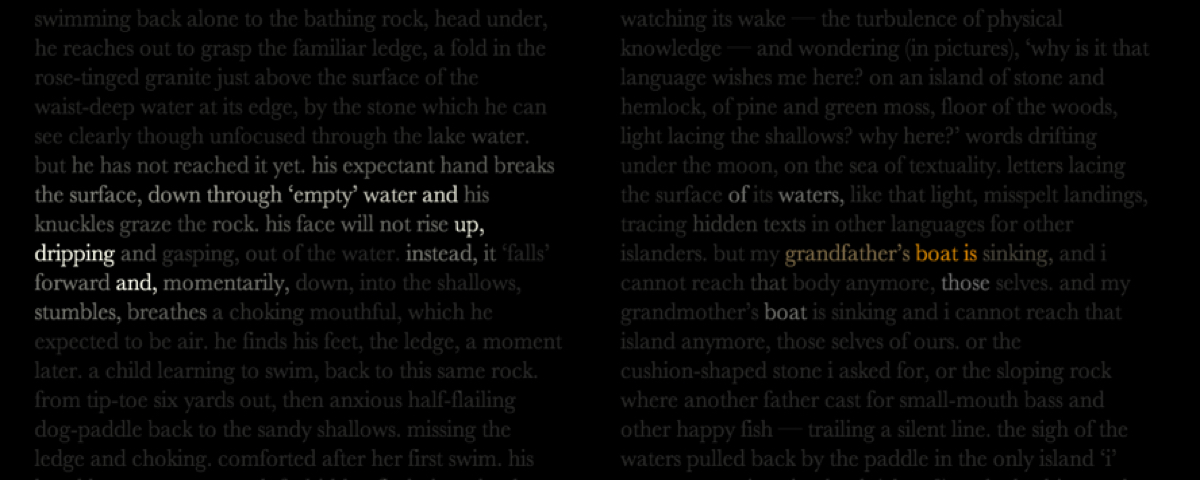
Poetics of Reading
You may download a simple runnable jar, here:
Poetry of Reading.
[ Please Note: This jar is offered 'as is', without support or warranty. Java has security and other peculiarities on all systems. On Macs, for example, you may have to Ctrl- or right-click in order to agree to open=run the jar. ]
There are two distinct texts on the page-like surfaces of this Poetics of Reading sampler: 'Misspelt Landings', a prose poem, and 'Poetic Caption', a poetic exposition of the readers' processes. Both texts are by John Cayley. When the application opens, 'Misspelt Landings' is on the first three pages and 'Poetic Caption' on the next three.
There are three readers that move through these pages when the program is opened. The first starts at the top left of the lefthand 'page', the second at the top left of the righthand page; the third reader starts at the left margin of the last line of the 'opening'. Each of the readers has different 'knowledge' of the texts, and differing reading strategies.
The fist reader—white—is a Perigram Reader that has information about all the collocational possibilities of word combinations in the typographic neighborhood of every word in both texts. It knows the perigrams of every word. It behaves consistently throughout its readings: highlighting its next word every half second and also somewhat brightening the words of the typographic neighborhood as it reads.
The second reader—ochre—is a Simple Reader. It follows the regular word order of conventional human reading of English prose, moving to each next word after a little more than half a second. This reader is also, however, a Spawning Reader. It spawns other algorithmic readers as it proceeds. It knows about the perigrammatic relationships between the word it is currently reading and this word's neighbors. If there is a relatively frequent natural language collocation in any direction other than immediately behind or ahead, it may spawn a reader or readers—light grey—that move off in the direction of a collocation. This spawned reader will 'live' only so long as there is still a natural language collocation in the direction of its momentum (usually only two or three words). The simple spawner, however, only knows about perigrams within the text of 'Misspelt Landings'. As it sets out within this text, it spawns readers regularly, but when it reaches the text of 'Poetic Caption' it goes quiet, spawning only as and when it happens to encounter perigrams that are shared between the two texts.
The third reader—brown—is a Perigram Reader like the first. However it only knows about the perigrams of 'Poetic Caption'. This means that so long as it is reading within 'Misspelt Landing' it almost always behaves like a Simple Reader because it only rarely recognizes as collocations any of the neighboring words of the word it is reading. This reader is also a Spawning Reader, like the second. Once again, and for complementary reasons, it only rarely spawns in 'Misspelt Landings'. But when it moves into 'Poetic Caption' it both deviates from a conventional reading path, according to its code as a Perigram Reader, and also spawns quite frequently.
When the program is running you have very limited control of the display. The spacebar can be used to pause or restart the readers, and the 'n' key can be used to move the display forward one page at a time. Please also note that the first, perigram, reader will cause the display to move forward by one page when it reaches the bottom right of a righthand page surface.
This runnable jar was - as for the original development environment of The Readers Project - written and generated using Processing and RiTa, the extensive natural language processing and text handling libraries for Processing by Daniel C. Howe. These now support Javascript with the same api.
Poetics of Reading is based on The Readers Project software, as first installed for Poetry Beyond Text in 2011 and represents one of the early works to emerge from the project. It was originally offered as a Java Applet, but lack of support and development from Big Software has had the consequence that this mode of distribution is unreliable. This runnable jar is provided for archive purposes and as an interim measure only.